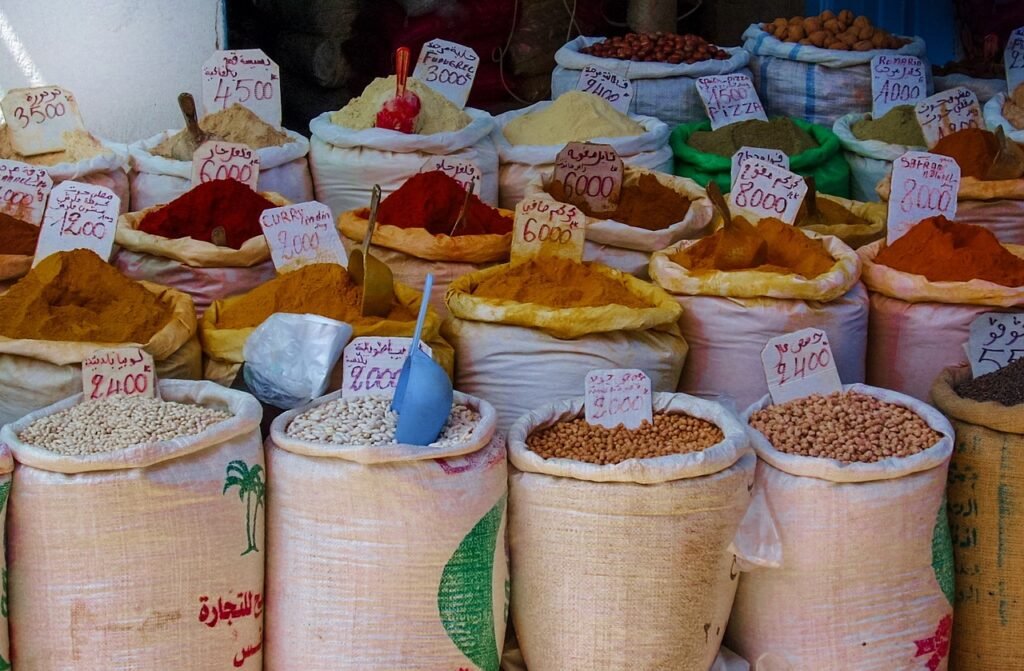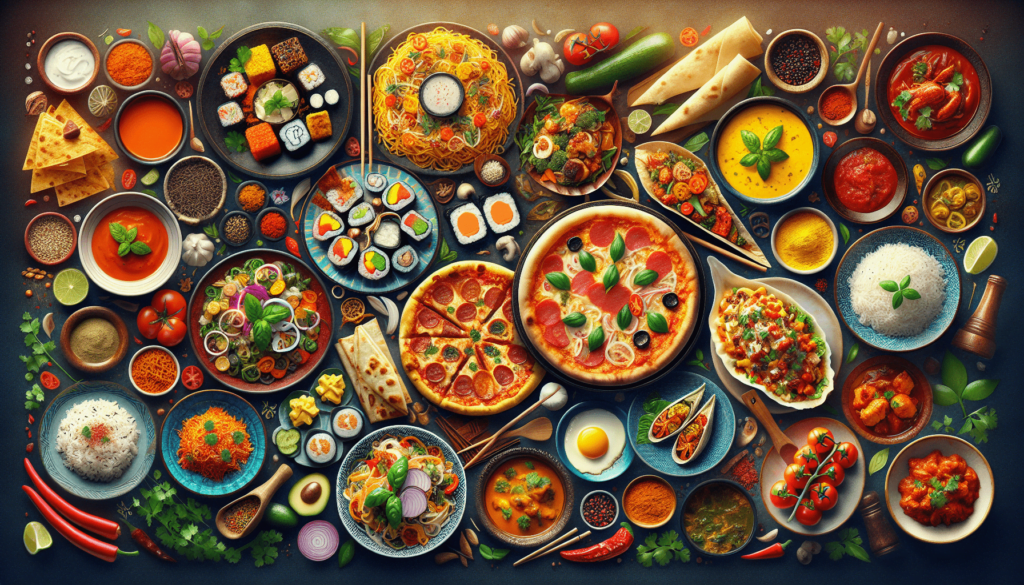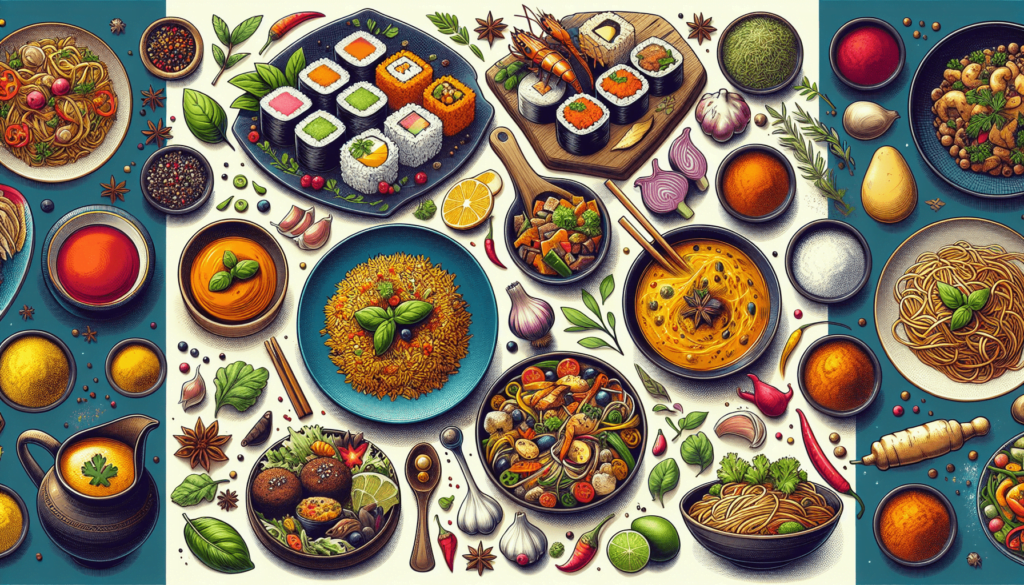Imagine embarking on a vibrant and mouthwatering journey which satisfies your wanderlust and gives your taste buds an unforgettable experience. That’s right! Prepare yourself for “Flavorful Journeys: Exploring Global Culinary Delights,” your personal guide to the mesmerizing world of international cuisines.
Travel from the cozy bistros of France to the bustling food markets of Thailand, from the timeless kitchens of Italy to the modern fusion restaurants of New York City. As you flip through each section, you’ll learn about the history of different culinary practices, recent trends that are shaping food cultures, a comprehensive understanding of distinct flavors and techniques, and engaging narratives that feature exciting examples from around the globe. It’s a flavorful journey you wouldn’t want to miss. Enjoy your global culinary adventure!
Table of Contents
Nurturing Global Culinary Enthusiasm
Innate human curiosity about global cuisines
As we traverse through this journey called life, it’s only natural for our innate human curiosity to extend toward the foods we eat. After all, who can resists the tantalizing aroma of exotic spices or the unique flavors from far-off lands? From the spicy notes of Indian curry to the subtle nuances of Japanese sushi, global cuisines have the power to transport us to different parts of the world, all from the comfort of our dining room.
Role world travel plays in exposing various culinary delights
Travel not only widens your horizons but also delights your palate with an array of culinary delights. You learn first-hand about the unique ingredients, cooking methods, and traditions that shape each cuisine. You get to savor authentic flavors, as you learn to appreciate the culinary diversity that our planet has to offer. Each bite, a journey, an exploration into the heart of a culture.
Impact of globalization on the accessibility of various cuisines
Thanks to globalization, our kitchens and dining tables have become melting pots of world cuisines. You don’t need a passport to try out Italian pasta, French crêpes, or Thai curry. Global cuisines have never been more accessible – through restaurants, home deliveries, ready-to-cook food kits, and a wealth of online recipes for the adventurous home cook.
Food as a window into a culture’s history and lifestyle
Besides being an absolute delight, food also offers a fascinating window into a culture’s history and lifestyle. It is a reflection of a region’s climate, geography, and cultural influences. Whether it’s the preference for raw fish in Japanese sashimi due to the country’s abundance in seafood or the prevalence of many pasta forms in Italian cuisine thanks to its rich wheat fields, food and culture are intertwined in a beautiful dynamic dance.
History of Global Cuisine
Historical influences on major global cuisines
Just like culture and languages, cuisines too have been shaped by history. The histories of many popular global cuisines have been shaped by trade, conquest, and migration. For instance, the famous Indian biriyani was introduced by the Mughals, while American fast food has spread globally courtesy of economic globalization.
Fusion cuisine through history: Mingling of flavors and techniques
Through the sands of time, food too has evolved, absorbed, and morphed into variations that are unique yet familiar. Fusion cuisine isn’t a modern invention; it has existed as long as different cultures have interacted. When new ingredients or cooking methods are introduced to a cuisine, they often lead to the creation of hybrid dishes that combine aspects of different culinary traditions.
Influence of colonization and trade routes on global food culture
History shows that wherever colonization and trade routes existed, food cultures evolved dynamically. Spices from the East traveled to Europe, while New World foods like tomatoes and potatoes were introduced to the Old World that arguably transformed their cuisines forever.

This image is property of pixabay.com.
Current Trends in Global Cuisine
Rising popularity of vegan and vegetarian dishes
With the increasing awareness about health and sustainability, there’s a shift towards plant-based diets. Traditional vegan and vegetarian dishes from around the world, that were once seen as exotic, are gaining popularity. From Italian pasta Primavera to Indian lentil curries, these dishes are becoming mainstream in global cuisine.
The farm-to-table movement
The farm-to-table movement has inspired people globally to reconnect with their food sources. This trend of using locally sourced ingredients not only supports local economies but also enables chefs to deliver the freshest and most authentic dishes.
Increasing demand for authentic and traditional dishes
People are increasingly seeking culinary experiences that are authentic and deeply rooted in traditions. Dishes that tell a story, dishes that transport them to another place or time. This trend has given rise to dining experiences centered around traditional foods, like Japanese kaiseki or Spanish tapas, that go beyond just food and provide a cultural immersion.
Conceptual Understanding of Global Cuisine
Interpreting key cultural aspects that influence a region’s cuisine
To truly understand a cuisine, one must delve into the cultural aspects that define it. Elements such as religious practices, social structures, and national identity often play a key role. For instance, Indian cuisine is heavily influenced by the Hindu practice of vegetarianism, leading to an array of plant-based dishes.
Definition and influence of ‘terroir’ on global cuisine
Terroir, a French term, refers to the environmental conditions, particularly soil and climate, in which food is grown. It’s a fundamental concept in the world of wine and cheese but extends far beyond. The concept of terroir emphasizes how the taste and flavor of food is influenced by where it comes from.
Significance of staple foods in different cuisines
Staple foods essentially define the base of any cuisine. They are mainly energy providers and usually cheap and easily accessible. Whether it’s rice in Asian dishes, potatoes in Irish cuisine, or corn in Mexican food, each staple influences the flavors and method of cooking in its respective cuisine.

This image is property of pixabay.com.
Exploring French Cuisine
Hallmarks of French cuisine
French cuisine is globally renowned for its finesse and flavor. From savory crepes, coq au vin to decadent desserts, French cuisine is characterized by its diverse regional influences, high-quality ingredients, and an unwavering commitment to ‘joie de vivre’ (joy of living).
Examining popular French dishes
Who hasn’t heard of croissants, escargot, or ratatouille? These popular French dishes have gained international acclaim for their unique flavors. Each dish has a story to tell, a reflection of its regional origin, ingredients, and cultural history.
Influence of French cuisine on the rest of the world
French cuisine has notoriously influenced global culinary practices, in the form of haute cuisine, the elaborate style of cooking popular in higher-end restaurants. French techniques and dishes have been adopted by other cuisines, rendering a universal appreciation for its iconic contribution to the culinary world.
Pleasures of Italian Cuisine
Key ingredients and techniques in Italian cuisine
Italian cuisine is loved for its simplicity and fresh flavors. Olive oil, pasta, tomatoes, and basil – these simple ingredients are key to Italian cooking. Along with these ingredients, techniques such as sauteing (soffritto) and reducing sauces (ragu) form the backbone of Italian cuisine.
Region-specific Italian dishes
While pizza and pasta may be universally known, Italian cuisine varies dramatically from region to region, from the seafood-based dishes of the coastal areas to the meat-centric fare of the inland areas. From Neapolitan pizza to Tuscan Chianti wine, regional distinctions are celebrated and cherished in Italy.
Italian food culture and its global popularity
Italian food culture places emphasis on quality of ingredients and convivial dining. This approach to food resonates globally, contributing to the cuisine’s popularity. Italian restaurants are omnipresent, and Italian dishes are adapted to please palates all over the globe.

This image is property of pixabay.com.
Spice Routes: Indian Cuisine
The role of spices in Indian cuisine
Indian cuisine is characterized by its deft use of a multitude of spices. The role of spices isn’t just to add heat but also to contribute flavors that make Indian cuisine so distinct. From fiery red chilies to fragrant cardamom, each spice plays a critical role.
Popular Indian regional foods
Indian cuisine dramatically changes from one region to another. North Indian cuisine is famous for its creamy curries and naans, South Indian for spicy lentil soups and rice pancakes, West Indian for its sea-food and sweets, and East Indian for its fish and rice. Each region offers a plethora of flavors, dictated by its climate, geography and local produce.
Influence of Indian food on global palate
From fragrant curries to fluffy naan bread, Indian food has found admirers globally. Indian restaurants have sprouted in cities around the world serving authentic and fusion Indian dishes. Not just restaurants, Indian spices and condiments are now a common sight at global supermarkets, a testament to its growing popularity.
The Zen of Japanese Cuisine
Influence of Zen Buddhism on Japanese food culture
Zen Buddhism has profoundly influenced Japanese cuisine, emphasizing respect for ingredients and mindful eating. The simplicity in Japanese cuisine is a reflection of Zen principles that aim to bring out the natural flavors of the ingredients without masking them with spices and heavy sauces.
Simplicity and seasonality in Japanese cuisine
Japanese cuisine is renowned for its simplicity and seasonality. Dishes are often prepared with minimal ingredients to highlight their natural tastes. Seasonality plays a pivotal role too, with the ingredients used in Japanese food changing with every season, reflecting the country’s deep-rooted respect for nature.
Global success of the sushi and ramen culture
Sushi and Ramen have taken the world by storm. These iconic Japanese dishes have captivated taste buds globally with their simplicity and umami-rich flavors. The artful presentation in Sushi and the comforting deliciousness of ramen have helped them become global phenomena.

Future of Global Cuisine
Predicting future trends in cuisine exploration
As we move forward, we’ll likely see more fusion cuisines emerging, blending of traditional and modern techniques, and a stronger emphasis on sustainability. Personalization in food will see a surge too, catering to dietary needs and preferences. Exploration of unknown regional cuisines may gain momentum, as food fanatics dive deeper into gastronomical delights.
The impact of technology on global food culture
Technology has already begun transforming the global food culture. From online recipe platforms to delivery apps, technology has made global cuisines more accessible than ever. Furthermore, with the advent of AI and molecular gastronomy, we’ll see an amalgamation of food and science creating culinary experiences that are truly out of this world.
Increasing popularity of sustainable and ethical food practices
Sustainable and ethical food practices are gaining worldwide acknowledgment. People are becoming more aware of their food choices’ impact on the environment and are seeking options that are not only healthy and delicious but also kind to the planet. From plant-based options to low-food-mile meals, the future of global cuisine will lean towards sustainability.
Conclusion and Engagement
Summarizing key points discussed and relating back to the hook
Global culinary enthusiasm reflects our intrinsic curiosity and love for food diversity. The history and evolution of global cuisine, the current trends and future predictions, all indicate a continuous journey of exploration and discovery. Just like that captivating aroma of spices or the unique flavors always leaving you yearn for more, the world of global cuisines is an endless epicurean adventure.
Encourage readers to engage with their own exploration of global cuisine
We encourage you to embark on this flavorful journey of exploration. Broaden your culinary horizon. And remember, it’s more than just about tasting different dishes. It’s about immersing yourself in different cultures, understanding history and various lifestyle through food. After all, the world is a deliciously large place!
Provide credible sources for further reading and exploration
While we’ve endeavored to provide a comprehensive introduction to global culinary delights, there are countless resources available to aid your exploration further. Food memoirs, cookbooks, documentaries, and cooking shows offer a wealth of information. Sourcing ingredients recreating exotic dishes, or simply experiencing new flavors at a local restaurant can all be part of your exciting culinary journey. Happy exploring!

Related site – Exploring the Culinary Delights
